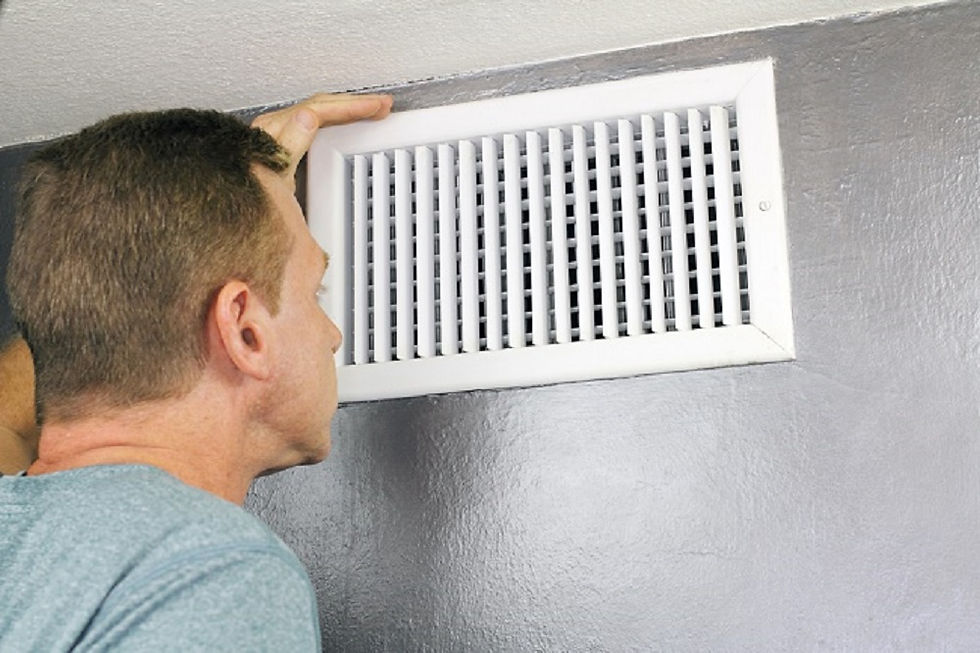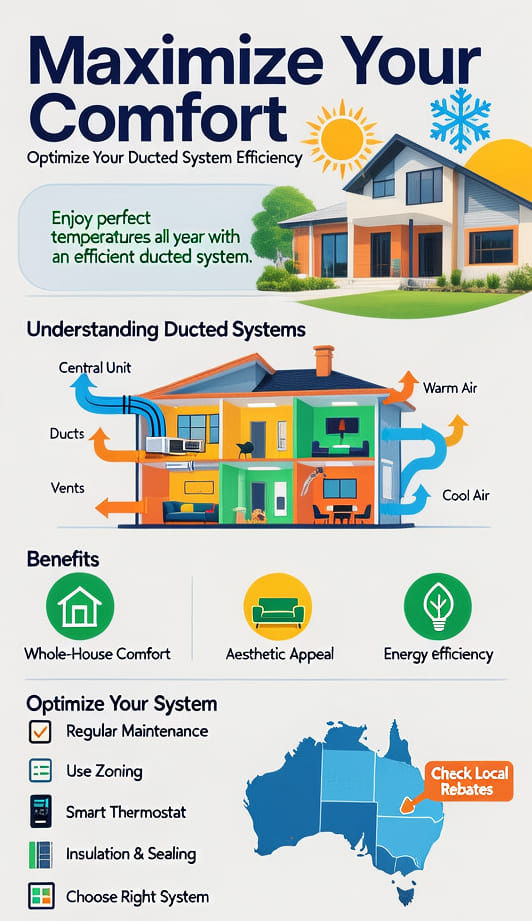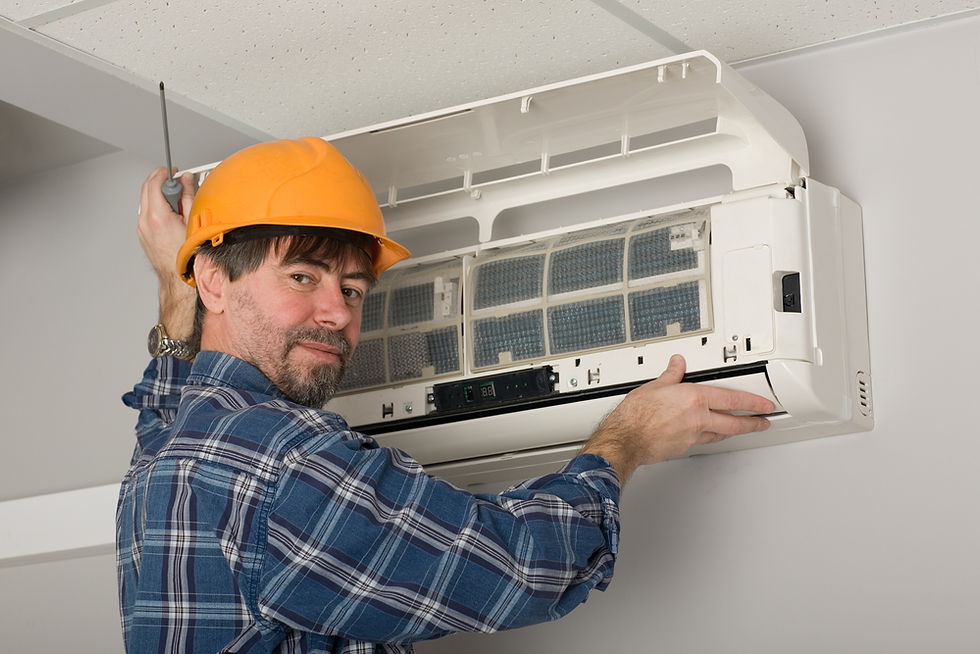How to Choose the Best Ducted Heating and Cooling System for Your Home
- Kate Westall
- Oct 7
- 7 min read
Hey there, Aussie homeowner! If you're staring down the barrel of another sweltering Sydney summer or a bone-chilling Melbourne winter, you're probably wondering how to keep your home comfortable year-round without breaking the bank. Enter ducted heating and cooling systems – the unsung heroes of Australian home comfort. These whole-home solutions distribute conditioned air through ducts hidden in your ceiling or floor, giving you even temperatures everywhere from the lounge room to the kids' bedrooms.
In this guide, we'll dive deep into everything you need to know about choosing the right ducted system for your Australian home. We'll cover the basics, the tech, the costs, and even those quirky local factors like bushfire-prone areas or state-specific rebates. Whether you're building new in Brisbane or retrofitting an older Queenslander in the suburbs, by the end, you'll feel confident making a decision that boosts your home's value and your family's comfort. Let's get into it.

What Is Ducted Heating and Cooling, and Why Is It a Game-Changer for Aussie Homes?
Ducted heating and cooling isn't just another HVAC buzzword – it's a versatile system that tackles Australia's wild weather head-on. At its core, it's a central unit (usually outdoors) connected to a network of ducts that snake through your home's roof space or underfloor. Indoor vents then push out warm or cool air, depending on the season.
Picture this: in the heat of a Perth summer hitting 40°C, your ducted reverse-cycle system chills the entire house evenly, without the hot spots you get from split systems. Come winter in Tasmania, it switches to heating mode, keeping frost at bay. Unlike portable units or wall-hung splits, ducted systems offer zoning – you can heat or cool just the living areas during the day and bedrooms at night, saving energy in our pricey electricity market.
Why's it so popular Down Under? Australia's climate is diverse – think humid tropics in Darwin versus dry heat in Adelaide. Ducted systems adapt beautifully, and with rising energy costs (hello, 20-30% hikes in some states post-2022), their efficiency is a lifesaver. Plus, they're discreet; no ugly indoor units cluttering your aesthetic. According to the Australian Institute of Refrigeration, Air Conditioning and Heating (AIRAH), ducted installs have surged 15% in the last five years, especially in new builds complying with the National Construction Code (NCC).
But it's not all smooth sailing. Installation can be invasive, especially in heritage homes in places like Hobart. That's why understanding your home's layout is key – we'll cover that next.
Key Factors to Consider When Selecting a Ducted System in Australia
Choosing the best ducted heating and cooling system feels overwhelming, but break it down, and it's manageable. Let's chat through the essentials, tailored to our local scene.
Assess Your Home's Size and Layout
First things first: measure twice, install once. For a typical three-bedroom home in Melbourne (around 200m²), you'll need a system with 10-12kW capacity. Larger spreads in regional NSW might demand 15kW or more. Factor in ceiling heights – high ceilings in a Federation-style home in Sydney mean more air volume to condition.
Don't forget insulation. Many Aussie homes, especially pre-1990s builds, leak energy like a sieve. Check your walls and roof; poor insulation could inflate running costs by 30%. Tools like the free NatHERS assessment (used for BASIX in NSW) can simulate your home's needs.
Zoning is your best mate here. Modern systems let you divide your home into zones (e.g., living vs. sleeping areas), controlled via apps. In multi-storey homes common in urban Perth, this prevents wasting energy on unused floors. Energy Efficiency: Navigating Australia's Star Ratings and Rebates
Aussies love a bargain, and nothing beats a system that slashes your power bill. Look for high energy efficiency ratings – the Higher the star rating on the Zoned and Centralised Energy Rating Label (ZCEL), the better. Aim for 6-7 stars; anything below 4 is outdated.
Reverse-cycle ducted systems are kings for dual heating/cooling, using heat pumps to move energy rather than generate it. In Victoria, the Victorian Energy Upgrades (VEU) program offers rebates up to $1,500 for efficient installs. Queensland's Climate Smart Energy Savers scheme can knock off similar amounts. Federally, small-scale tech certificates (STCs) under the Renewable Energy Target can subsidize solar-integrated systems.
Watch for variable-speed compressors – they adjust output to match demand, cutting bills by 20-40% compared to fixed-speed models. In hot spots like Darwin, inverter tech handles humidity without overworking.
Types of Ducted Systems: Gas, Reverse-Cycle, or Hybrid?
Options abound, so let's unpack them.
Reverse-Cycle Ducted Systems: The all-rounder. Uses electricity to heat or cool via refrigerant. Brands like Daikin and Mitsubishi Electric dominate, with models like Daikin's Premium Inverter offering quiet operation (under 30dB). Ideal for most Aussie climates, but electricity costs sting in high-use areas like South Australia.
Gas Ducted Heating: Perfect for colder regions like the ACT or Victoria's highlands. Brands such as Brivis and Bonaire use natural gas for quick, dry heat. Pair it with evaporative cooling for summer in drier spots like Adelaide. Pros: Cheaper to run where gas is plentiful (e.g., WA's domestic gas reservations). Cons: Not great for humid areas; needs venting.
Hybrid Systems: Combine gas heating with reverse-cycle cooling. Emerging in eco-conscious homes in Brisbane, these balance efficiency and cost. Look at ActronAir's hybrids, which integrate smart controls for seamless switching.
Evaporative cooling add-ons suit arid zones – think Port Augusta – but skip them in coastal humidity.
Installation Costs and Local Regulations
Budget-wise, expect $8,000-$20,000 for a full install, depending on home size and complexity. In Sydney, labor runs $5,000+ due to tradie shortages; regional areas like rural Victoria might be cheaper but harder to schedule.
Regulations matter. All installs must comply with AS/NZS 3666 for air handling and the NCC for energy efficiency. In bushfire zones (e.g., much of NSW and VIC), choose ember-resistant outdoor units. Get a licensed installer – check the Australian Refrigeration Council (ARC) registry. Pre-approvals for strata in apartments (common in Melbourne) can add red tape.
Local providers? Daikin has nationwide service, but regional heroes like Coolair in Queensland or Reece HVAC in Perth offer tailored advice. Competitors: Fujitsu vs. Toshiba for budget options; Panasonic for premium zoning.
Maintenance and Long-Term Savings: Keeping Your System Running Smoothly
A ducted system lasts 15-25 years, but neglect it, and you'll pay. Annual servicing ($200-400) cleans filters, checks ducts for leaks, and ensures compliance with health standards – vital in dusty outback areas.
Smart tech amps up savings: Wi-Fi controls from brands like Braemar let you preheat via app before arriving home from work. Integrate with solar panels (booming in sunny QLD and NSW) for near-zero running costs.
Environmentally, ducted systems reduce carbon footprints when efficient. With Australia's net-zero push by 2050, choosing low-GWP refrigerants (like R32 over R410A) future-proofs your install.
Incorporate air quality features too – post-bushfire smokes in 2019-2020 highlighted the need for HEPA filters in systems from ActronAir.

Questions and Answers: Common Questions About Ducted Heating and Cooling in Australia
Got queries? We've rounded up some top ones from Aussie homeowners, based on forums like Whirlpool and local HVAC chats.
Q: What are the energy efficiency standards for ducted heating and cooling systems in Australia?
Ans: All systems must meet the Minimum Energy Performance Standards (MEPS) under the Greenhouse and Energy Minimum Standards (GEMS) Act. Look for the yellow Energy Rating Label: 1-10 stars for cooling, similar for heating. In states like NSW, BASIX requires simulations showing 6-star equivalents for new homes. High-efficiency models (7+ stars) qualify for rebates, saving you hundreds upfront.
Q: How much does it cost to install ducted heating and cooling in a typical Australian home?
Ans: For a 200-250m² home, installation ranges from $10,000-$18,000, including the unit, ducts, and labor. Costs vary by location – higher in capital cities like Sydney ($12,000+ average) due to permits and access. Add $1,000-2,000 for zoning. Running costs? Efficient systems average $200-500/year for a family of four, less with solar offsets.
Q: Are ducted systems suitable for older homes in Australia?
Ans: Absolutely, but retrofits can be tricky. In pre-war homes in Melbourne or Brisbane's weatherboards, underfloor ducts might work better than ceiling ones to avoid structural hassles. Expect 10-20% higher costs for mods. Consult an ARC-licensed pro for feasibility – many older homes in humid QLD benefit from dehumidifying features to combat mould.
Q: What rebates are available for ducted heating and cooling in Australia?
Ans: State schemes shine: Victoria's VEET offers up to $2,000 for upgrades; Queensland's CSE up to $1,500. Federally, the Small-scale Renewable Energy Scheme provides STCs worth $300-600 for solar-linked systems. Check your postcode on energy.gov.au – eligibility often ties to income or home age. In SA, the Home Energy Advice program guides low-income households.
Q: How do I choose between major brands like Daikin and Brivis for ducted systems?
Ans: Daikin excels in reverse-cycle efficiency and quiet operation, ideal for urban noise-sensitive areas like inner Sydney. Brivis leads in gas heating for colder climates like Canberra, with strong local warranties (up to 10 years). Compare via Choice reviews or Energy Star ratings. Factor service networks – Daikin's ubiquitous, but Brivis has edges in VIC/NSW.
Conclusion: Your Path to a Successful Ducted Heating and Cooling Installation in Australia
Wrapping it up, selecting the best ducted heating and cooling system boils down to matching your home's needs with efficient, compliant tech that suits Australia's unique climate and regs. We've covered the whys (whole-home comfort without the fuss), the hows (sizing, types, and zoning), and the must-knows (costs, rebates, and maintenance) – all with an eye on local realities like bushfire standards or state incentives.
The payoff? A cozier, greener home that could add 5-10% to your property value, per real estate data from Domain. Next steps: Start with a free energy audit via your state's scheme (e.g., Energy Makeovers in WA). Get 3-4 quotes from ARC-licensed installers – compare brands like Daikin for versatility or Brivis for gas pros. Check eligibility for rebates on government sites, and if building new, weave it into your NCC plans early.
Ready to beat the heat (or chill)? Your dream setup is just a consultation away. Breathe easy, Australia – comfort is calling.









Comments